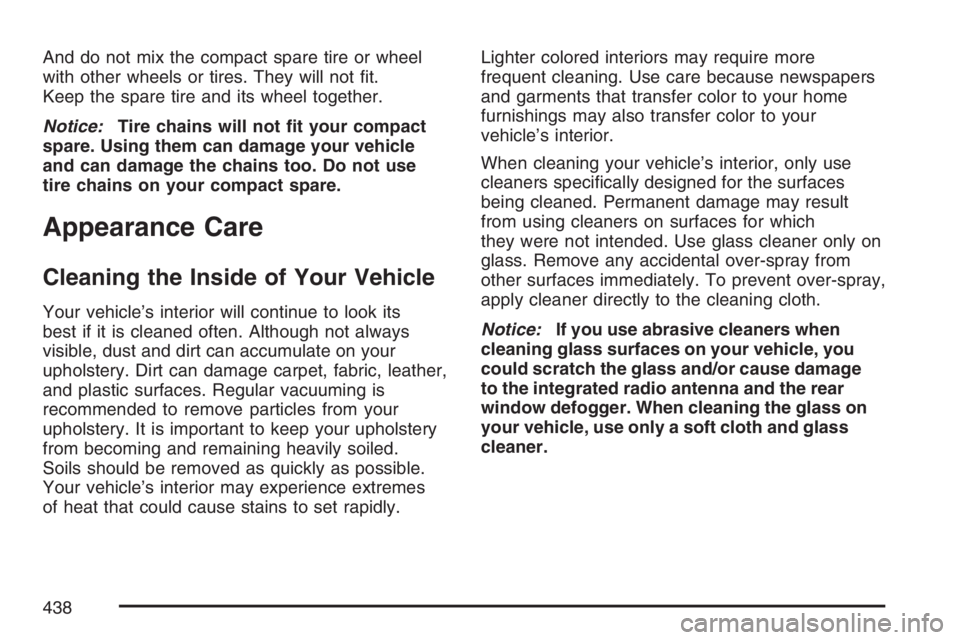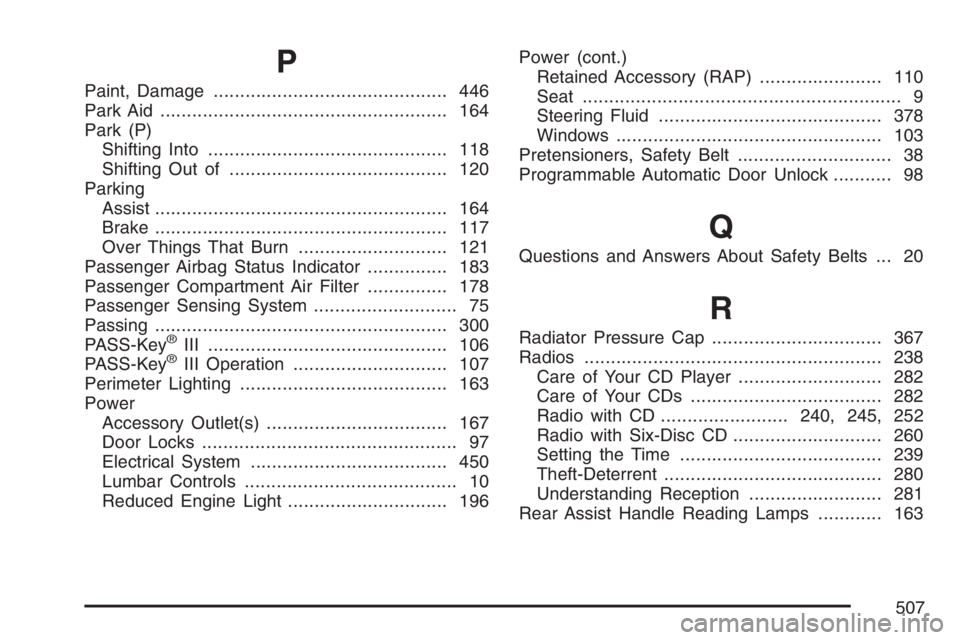2007 BUICK LACROSSE radio
[x] Cancel search: radioPage 411 of 512

Tire Pressure Monitor System
The Tire Pressure Monitor System (TPMS) uses
radio and sensor technology to check tire pressure
levels. TPMS sensors are mounted onto each
tire and wheel assembly, except for the spare tire.
The TPMS sensors monitor the air pressure in
your vehicle’s tires and transmit tire pressure
readings to a receiver located in the vehicle.
When a low tire pressure condition is detected,
the TPMS illuminates the low tire pressure
warning light, located in the instrument panel
cluster. If your vehicle has the uplevel Driver
Information Center (DIC), a warning message to
check the pressure in a speci�c tire displays at
the same time the low tire pressure warning light
comes on. The low tire pressure warning light
and the DIC warning message CHECK TIRE
PRESSURE come on at each ignition cycle
until the tires are in�ated to the correct
in�ation pressure. Vehicles that have the
uplevel DIC buttons can also check tire
pressure levels by pressing the gages button.For additional information and details about the
DIC operation and displays seeDIC Operation and
Displays on page 200andDIC Warnings and
Messages on page 208.
During cooler weather conditions, the low tire
pressure warning light and the DIC warning
message, if your vehicle has this feature, may
come on when the vehicle is �rst started, and then
turn off as you start to drive. This could be an
early indicator that the air pressure in the tire(s)
are getting low and need to be in�ated to the
proper pressure.
Each tire, including the spare (if provided), should
be checked monthly when cold and in�ated
to the in�ation pressure recommended by the
vehicle manufacturer on the vehicle placard or tire
in�ation pressure label. (If your vehicle has tires
of a different size than the size indicated on
the vehicle placard or tire in�ation pressure label,
you should determine the proper tire in�ation
pressure for those tires.)
411
Page 415 of 512

6. Proceed to the passenger side front tire,
and repeat the procedure in Step 5.
7. Proceed to the passenger side rear tire,
and repeat the procedure in Step 5.
8. Proceed to the driver side rear tire, and
repeat the procedure in Step 5.
9. After hearing the con�rming horn chirp for the
driver side rear tire, the horn chirps two more
times to signal the tire learning process
has ended. Turn the ignition switch to OFF.
10. Set all four tires to the recommended air
pressure level as indicated on the tire and
loading information label.
11. Put the valve caps back on the valve stems.Federal Communications Commission
(FCC) and Industry and Science Canada
The Tire Pressure Monitor System (TPMS)
operates on a radio frequency and complies with
Part 15 of the FCC Rules. Operation is subject
to the following two conditions:
1. This device may not cause harmful
interference.
2. This device must accept any interference
received, including interference that may
cause undesired operation.
The Tire Pressure Monitor System (TPMS)
operates on a radio frequency and complies with
RSS-210 of Industry and Science Canada.
Operation is subject to the following two conditions:
1. This device may not cause interference.
2. This device must accept any interference
received, including interference that may
cause undesired operation of the device.
Changes or modi�cations to this system by other
than an authorized service facility could void
authorization to use this equipment.
415
Page 438 of 512

And do not mix the compact spare tire or wheel
with other wheels or tires. They will not �t.
Keep the spare tire and its wheel together.
Notice:Tire chains will not �t your compact
spare. Using them can damage your vehicle
and can damage the chains too. Do not use
tire chains on your compact spare.
Appearance Care
Cleaning the Inside of Your Vehicle
Your vehicle’s interior will continue to look its
best if it is cleaned often. Although not always
visible, dust and dirt can accumulate on your
upholstery. Dirt can damage carpet, fabric, leather,
and plastic surfaces. Regular vacuuming is
recommended to remove particles from your
upholstery. It is important to keep your upholstery
from becoming and remaining heavily soiled.
Soils should be removed as quickly as possible.
Your vehicle’s interior may experience extremes
of heat that could cause stains to set rapidly.Lighter colored interiors may require more
frequent cleaning. Use care because newspapers
and garments that transfer color to your home
furnishings may also transfer color to your
vehicle’s interior.
When cleaning your vehicle’s interior, only use
cleaners speci�cally designed for the surfaces
being cleaned. Permanent damage may result
from using cleaners on surfaces for which
they were not intended. Use glass cleaner only on
glass. Remove any accidental over-spray from
other surfaces immediately. To prevent over-spray,
apply cleaner directly to the cleaning cloth.
Notice:If you use abrasive cleaners when
cleaning glass surfaces on your vehicle, you
could scratch the glass and/or cause damage
to the integrated radio antenna and the rear
window defogger. When cleaning the glass on
your vehicle, use only a soft cloth and glass
cleaner.
438
Page 451 of 512

Fuses Usage
DR/LCK
TRUNKDoor Locks, Trunk
RFA/MOD Remote Keyless Entry
PRK/SWTCH Ignition Key Lock
CLSTR Cluster
STR/WHL/
ILLUMSteering Wheel Controls
Illumination
ONSTAR/ALDL OnStar
®, Data Link
Fuses Usage
INT/ILLUM Interior Lamps
PWR/SEAT Power Seat
S/ROOF Sunroof
CNSTR Canister Vent
HVAC Climate Control System
HAZRD Turn Signal, Hazard
PRK/LAMP Park Lamps
CHMSL/BKUPCenter-High-Mounted
Stoplamp/Back-up Lamps
PWR/MIR Power Mirrors
CRUISE Cruise Control
RDO/AMP Radio, Ampli�er
HTD/SEAT Heated Seats
HTD/MIR Heated Mirrors
PWR/WNDW Power Window
Relays Usage
RAP Retained Accessory Power
PRK/LAMP Park Lamp Relay
R/DEFOG Rear Defogger Relay
451
Page 497 of 512

A
Accessories and Modi�cations..................... 341
Accessory Power Outlet(s).......................... 167
Adding Equipment to Your Airbag-Equipped
Vehicle....................................................... 81
Additives, Fuel............................................ 344
Add-On Electrical Equipment....................... 449
Air Cleaner/Filter, Engine............................. 358
Air Conditioning..................................168, 172
Airbag
Passenger Status Indicator....................... 183
Readiness Light....................................... 182
Airbag Sensing and Diagnostic
Module (SDM).......................................... 489
Airbag System............................................... 66
Adding Equipment to Your
Airbag-Equipped Vehicle......................... 81
How Does an Airbag Restrain?.................. 73
Passenger Sensing System....................... 75
Servicing Your Airbag-Equipped Vehicle..... 80
What Makes an Airbag In�ate?.................. 73
What Will You See After an Airbag
In�ates?................................................. 74
When Should an Airbag In�ate?................. 71
Where Are the Airbags?............................. 68Antenna, Backglass..................................... 283
Antenna, XM™ Satellite Radio
Antenna System....................................... 284
Anti-Lock Brake System (ABS).................... 291
Anti-Lock Brake, System Warning Light....... 187
Appearance Care
Aluminum or Chrome-Plated Wheels........ 444
Care of Safety Belts................................ 442
Chemical Paint Spotting........................... 446
Cleaning Exterior Lamps/Lenses.............. 443
Cleaning the Inside of Your Vehicle.......... 438
Fabric/Carpet........................................... 440
Finish Care.............................................. 443
Finish Damage......................................... 446
Instrument Panel, Vinyl, and Other
Plastic Surfaces.................................... 441
Leather.................................................... 441
Sheet Metal Damage............................... 445
Tires........................................................ 445
Underbody Maintenance........................... 446
Vehicle Care/Appearance Materials.......... 447
Washing Your Vehicle .............................. 442
Weatherstrips........................................... 442
Windshield and Wiper Blades................... 444
Ashtray(s).................................................... 168
497
Page 498 of 512

Audio System(s).......................................... 238
Audio Steering Wheel Controls................. 280
Backglass Antenna................................... 283
Care of Your CD Player........................... 282
Care of Your CDs.................................... 282
Chime Level Adjustment........................... 284
Radio with CD........................240, 245, 252
Radio with Six-Disc CD............................ 260
Setting the Time...................................... 239
Theft-Deterrent Feature............................ 280
Understanding Radio Reception............... 281
XM™ Satellite Radio Antenna System...... 284
Automatic Door Lock..................................... 98
Automatic Transaxle
Fluid........................................................ 360
Operation................................................. 114
B
Backglass Antenna...................................... 283
Battery........................................................ 384
Electric Power Management..................... 163
Exterior Lighting Battery Saver................. 160
Run-Down Protection............................... 164
Before Leaving on a Long Trip.................... 310Brake
Anti-Lock Brake System (ABS)................. 291
Emergencies............................................ 293
Parking.................................................... 117
System Warning Light.............................. 186
Brakes........................................................ 381
Braking....................................................... 290
Braking in Emergencies............................... 293
Break-In, New Vehicle................................. 109
Bulb Replacement....................................... 394
Front Turn Signal and Parking Lamps...... 397
Halogen Bulbs......................................... 394
Headlamp Aiming..................................... 391
License Plate Lamps................................ 400
Replacement Bulbs.................................. 400
Taillamps, Turn Signal, Sidemarker,
Stoplamps, and Back-Up Lamps........... 398
Buying New Tires........................................ 418
498
Page 507 of 512

P
Paint, Damage............................................ 446
Park Aid...................................................... 164
Park (P)
Shifting Into............................................. 118
Shifting Out of......................................... 120
Parking
Assist....................................................... 164
Brake....................................................... 117
Over Things That Burn............................ 121
Passenger Airbag Status Indicator............... 183
Passenger Compartment Air Filter............... 178
Passenger Sensing System........................... 75
Passing....................................................... 300
PASS-Key
®III ............................................. 106
PASS-Key®III Operation............................. 107
Perimeter Lighting....................................... 163
Power
Accessory Outlet(s).................................. 167
Door Locks................................................ 97
Electrical System..................................... 450
Lumbar Controls........................................ 10
Reduced Engine Light.............................. 196Power (cont.)
Retained Accessory (RAP)....................... 110
Seat............................................................ 9
Steering Fluid.......................................... 378
Windows.................................................. 103
Pretensioners, Safety Belt............................. 38
Programmable Automatic Door Unlock........... 98
Q
Questions and Answers About Safety Belts ... 20
R
Radiator Pressure Cap................................ 367
Radios........................................................ 238
Care of Your CD Player........................... 282
Care of Your CDs.................................... 282
Radio with CD........................240, 245, 252
Radio with Six-Disc CD............................ 260
Setting the Time...................................... 239
Theft-Deterrent......................................... 280
Understanding Reception......................... 281
Rear Assist Handle Reading Lamps............ 163
507
Page 510 of 512

Starting Your Engine................................... 111
Steering...................................................... 297
Steering Wheel Controls, Audio................... 280
Steering Wheel, Tilt Wheel.......................... 151
Storage Areas
Center Console Storage Area................... 142
Convenience Net..................................... 142
Cupholder(s)............................................ 141
Glove Box................................................ 141
Stuck in Sand, Mud, Ice, or Snow............... 318
Sun Visors.................................................. 104
Sunroof....................................................... 143
T
Tachometer................................................. 181
Taillamps
Turn Signal, Sidemarker, Stoplamps, and
Back-Up Lamps.................................... 398
TCS Warning Light...................................... 187
Theater Dimming......................................... 162
Theft-Deterrent, Radio................................. 280
Theft-Deterrent Systems.............................. 104
Content Theft-Deterrent............................ 104
PASS-Key
®III .......................................... 106
PASS-Key®III Operation.......................... 107Tilt Wheel.................................................... 151
Tire
Pressure Light.......................................... 190
Tires........................................................... 402
Aluminum or Chrome-Plated Wheels,
Cleaning............................................... 444
Buying New Tires..................................... 418
Chains..................................................... 424
Changing a Flat Tire................................ 426
Cleaning.................................................. 445
Compact Spare Tire................................. 437
Different Size........................................... 420
If a Tire Goes Flat................................... 425
In�ation - Tire Pressure............................ 409
Inspection and Rotation............................ 416
Installing the Spare Tire........................... 429
Pressure Monitor System ......................... 411
Removing the Flat Tire............................. 429
Removing the Spare Tire and Tools......... 427
Storing a Flat or Spare Tire and Tools..... 435
Tire Sidewall Labeling.............................. 403
Tire Terminology and De�nitions............... 406
Uniform Tire Quality Grading.................... 421
Wheel Alignment and Tire Balance........... 422
Wheel Replacement................................. 422
When It Is Time for New Tires................. 417
510